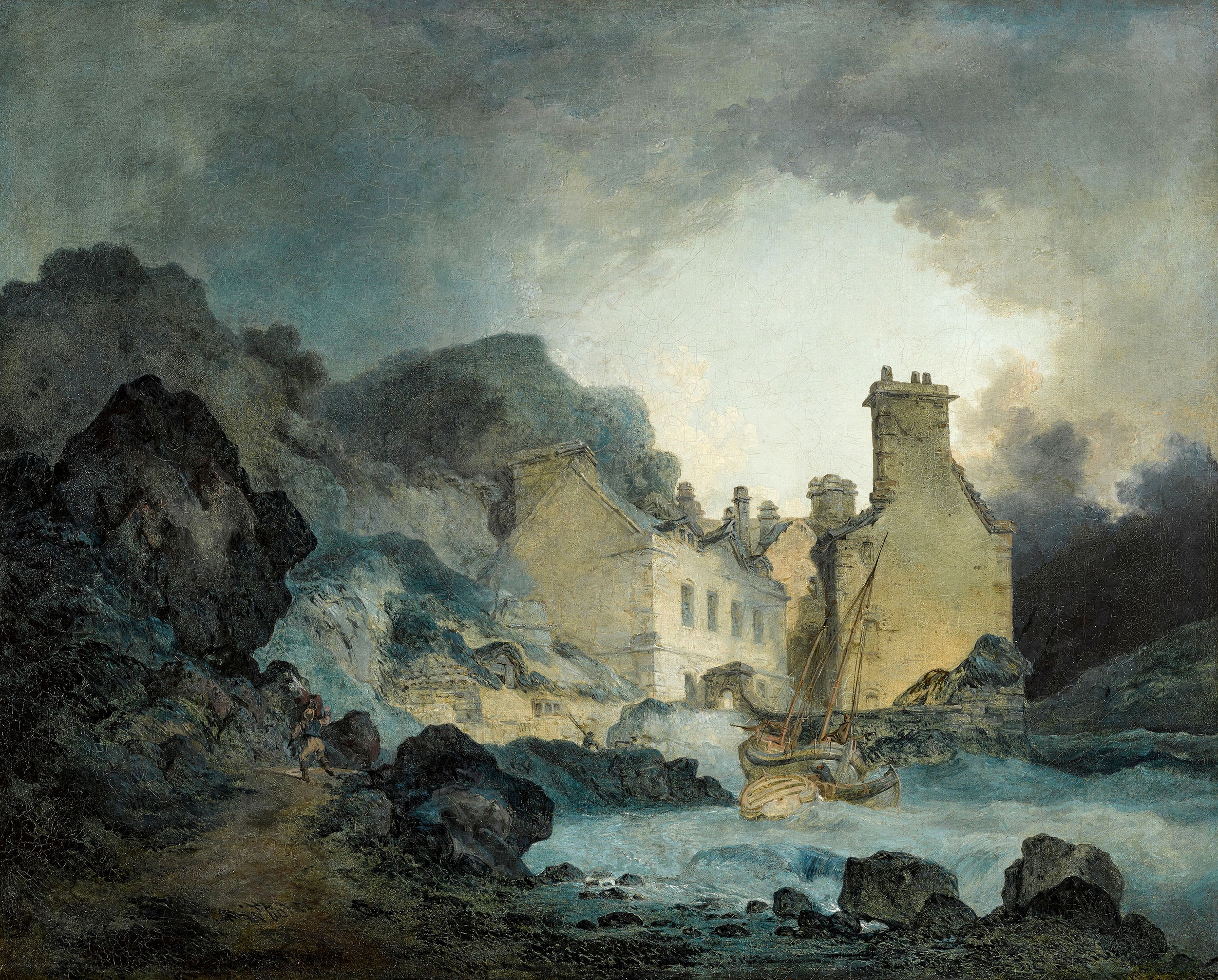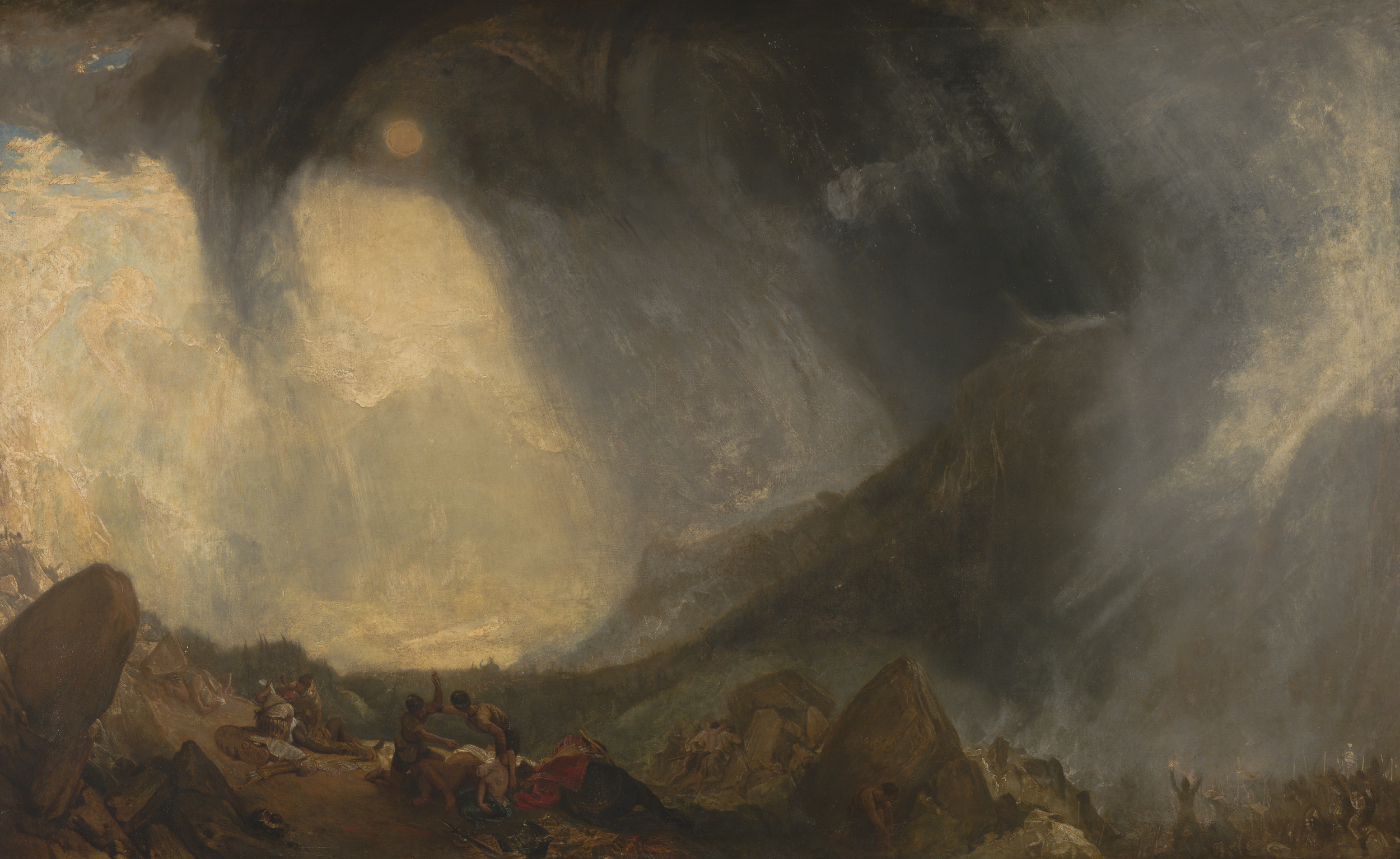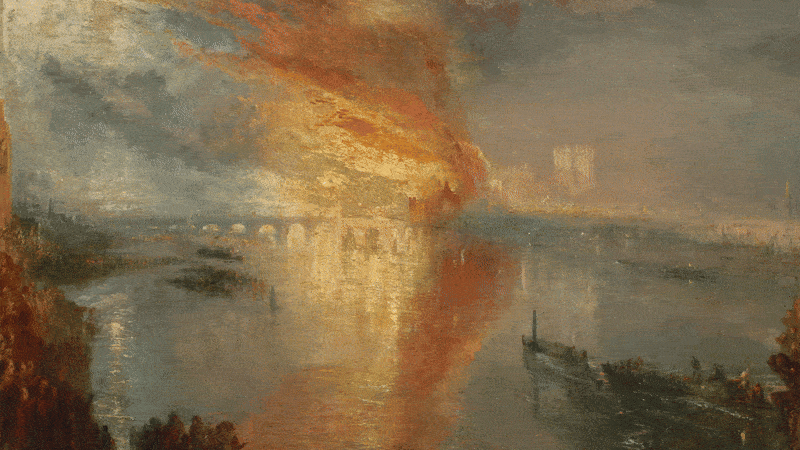There is a great scene in Mike Leigh’s biopic Mr Turner that dramatises an episode at the Royal Academy in 1832. Seeing his contemporary John Constable putting the finishing touches to his nearby epic, the red-flecked The Opening of Waterloo Bridge, JMW Turner picks up a brush laden with red paint and smooshes a single blob into the centre of his own muted nautical scene, Helvoetsluys, to represent a buoy — and blows Constable’s comparatively fussy picture out of the water.
Constable’s stunned response is said to have been: “He has been here and fired a gun.” In the movie he storms out in a huff.
Amy Concannon, the curator of the forthcoming exhibition Turner and Constable, at Tate Britain, which brings together the work of these two titans 250 years after their births, thinks it’s possible that Constable’s fabled flounce has been misconstrued. What if it were said more in admiration than in anguish? What if the explosion he referred to wasn’t a shot across the bows, but the crack of a starting pistol?
• The best exhibitions in London and the UK to book for August 2025
“My take is that actually, in 1831, Constable had fired the first shot, because he’d put his work by [that of] Turner, side by side [at the Royal Academy],” she says. Constable had been on the hanging committee for the exhibition that year, so must have influenced the placement.
It certainly caused a stir, with critics describing Turner’s Caligula’s Palace and Bridge as “all heat” to the “humidity” of Constable’s Salisbury Cathedral from the Meadows (both are in the Tate show). Another called it a demonstration of “Turner’s fire and Constable’s rain”. The race was on. Now their work is side by side again in a landmark exhibition that shows the full span of both artists’ careers.

Turner’s The Rising Squall, Hot Wells, from St Vincent’s Rock, Bristol
SOTHEBY’S
Never-seen-before work
Although it seems unimaginable, there will be works at Tate that visitors may not have seen before. Turner’s The Rising Squall, Hot Wells, from St Vincent’s Rock, Bristol was discovered just last year, after it was bought (as being painted by “a follower of Julius Caesar Ibbetson”) at auction in Newbury, then sent for restoration by its new owner, whereupon Turner’s signature was revealed. It was last on public display in 1793, when Turner exhibited it at the Royal Academy, aged 17 — it’s now his earliest known oil painting.
Then there’s The Burning of the Houses of Lords and Commons, 16 October 1834, on loan from Cleveland Museum of Art, which has not been seen in a public exhibition in Britain since 1883. Neither the privately owned Ancient Italy — Ovid Banished from Rome, 1838, nor The Fifth Plague of Egypt, 1800, from Indianapolis Museum of Art, have been seen here since the Seventies.
As for Constable, it’s a coup to get his massive The White Horse, 1819, from the Frick Collection in New York, and his last 6ft sketch, Stoke-by-Nayland, c 1835–7, from the Art Institute of Chicago, both here for the first time in nearly 20 years.

John Constable by Ramsay Richard Reinagle c 1799…
NATIONAL PORTRAIT GALLERY, LONDON

… and J.M.W. Turner, Self-Portrait c 1799
TATE
Fire and water
Perhaps a rivalry was inevitable. Born just a year apart, Turner in the noise and bustle of London’s Covent Garden and Constable in the rural peace of East Bergholt, Suffolk, both were outsiders in the London art world.
Turner’s father, William, was a barber and purveyor of wigs, and the dominant parent, his mother, Mary, having been committed to an institution in his early childhood due to mental illness.
• 150 years later, a Turner painting revealed beneath cracked varnish
“Covent Garden was the heart of commercial London,” Concannon says. “But it was also near the Royal Academy, then at Somerset House. It isn’t a big leap to think that some of Turner’s dad’s customers were involved with the Royal Academy. There were chances to converse with people who had made art their career.”
Turner’s talent had shown from an early age — according to legend, he displayed his drawings in his father’s shop window. “Turner’s dad was behind him all the way,” Concannon says, explaining that is the big difference at this point in the two painters’ lives. Constable was born a year later, in an “elegant house” in the Suffolk countryside, to a wealthy merchant father whose primary concern was that he would be “a gentleman”. Constable’s parents recognised the commercial potential of him becoming an artist, “but for them, the monetisation of that kind of talent was vulgar in itself, because you had to self-promote”.

Turner’s Snow Storm: Hannibal and his Army Crossing the Alps
TATE
His parents did eventually get on board and allowed Constable to attend the Royal Academy, with a bursary from his father. “So they weren’t entirely unsupportive, but he reached the Royal Academy seven years later than Turner had. He was 21, and if you think that Turner was 14, that’s quite a big difference.” By 27, Turner was a full Academician.
No wonder Constable consciously presented himself as the opposite equal of his contemporary — he wrote in a letter: “I feel deeply the honour of having found an original style & independent of him who would be Lord over all — I mean Turner.”
• Read more art reviews, guides and interviews
This snarky sally is consistent with a man who liked to laugh but could be petty, such as when he referred to Turner’s mammoth print project and landscape art manifesto, Liber Studiorum, started in 1806, as the “liber stupidorum”. Several years later, perhaps when he felt safe from comparison, Constable did one himself.

The Opening of Waterloo Bridge (‘Whitehall Stairs, June 18th, 1817’) by Constable
TATE
They differed in outlook too. Turner, whose father became his studio assistant as his fame and fortune grew, was a total artist — to the detriment of his family, which included Sarah Danby, a widow by whom he had two daughters, neither of whom he acknowledged. In his later years he lived with another widow, Sophia Booth, in Chelsea, but he reputedly once said: “I hate married men … they never make any sacrifice to the arts, but are always thinking of their duty to their wives and families, or some rubbish of that sort.”
Constable was precisely the kind of family man that Turner apparently despised — father of seven and sole parent to them after the death of his adored wife, Maria, in 1828, aged 41. Possibly understandably then, Constable never left England, whereas Turner was an intrepid traveller, visiting the Netherlands, France, Italy and Switzerland.
A useful rivalry?
But, Concannon says, there are plenty of similarities. “They were equally serious, equally ambitious,” and “between them, they revolutionised landscape painting”. When they started, landscape was pretty far down the hierarchy at the Academy, which favoured history painting — only still life (flowers, ugh) was lower.
Commercially, though, landscape was “where the buzz was”, Concannon says, describing it in the exhibition catalogue as “a dynamic area of opportunity”, with many possible formats and “an appeal to armchair tourists and souvenir seekers”.
Turner was the first to successfully marry the grandeur of history painting with landscape in a way that brought out a pathetic fallacy and enhanced the picture’s narrative — his 1812 canvas Snow Storm, Hannibal Crossing the Alps will be in the show. A swirling image of the terrifying sublime is made instantly into a history painting by the inclusion of Hannibal’s army as tiny figures in the distance (including a wee elephant).

Turner’s Ovid Banished From Rome
ALAMY
It’s harder to see Constable’s big idea, Concannon says, “but to make the kinds of pictures that he was making on such a grand scale, that was ballsy”. An image such as Flatford Mill from a Lock on the Stour, 1811, is a “prosaic, everyday scene that would mean something to the British public at that time — he was looking to appeal to people’s understanding that nature drives Britain’s prosperity and the natural order of society, man working with man in a hierarchy.
“He was a Tory, he was quite adamant that people stay in their lane, but that they’re doing so in this world that God has created.”
Both artists reflected their times, whether it’s the clash of the new industrial era with nature in Turner’s Snow Storm, Steam-Boat off a Harbour’s Mouth from 1842, or the threat posed by reform to the Anglican Church’s political authority in Constable’s ominous Salisbury Cathedral (he added the rainbow later, when it became clear it wasn’t going to be as bad as all that).
In a film made for the exhibition, the painter George Shaw (who favours Constable) calls him “a quiet shouter … The darkness that’s present in Constable’s paintings is evidence of the changing face of British society. We have the Inclosure Act coming in, things aren’t as harmonious as they seem in the cornfield. There’s a lot of poverty, there’s war on the horizon — these things are always in the corners.”

Turner’s Helvoetsluys: the City of Utrecht, 64, Going to Sea
ALAMY
They were technical innovators too, Constable in his scumbled application of paint, which after years of people griping about it, he stopped doing just as everyone else started picking up their palette knives (he was prone to moments of self-doubt, something Turner never suffered from); Turner pushed the medium of watercolour well beyond anything done previously.
So their rivalry did neither of them any harm. And although they clearly weren’t friends, there was a grudging respect between them. When Constable finally made it into the Academy in 1829, squeaking in by a single vote, Turner called on him to offer his congratulations, and they spent the evening together with another artist, George Jones, the party breaking up at 1am “mutually pleased with one another”, according to Constable. He later admitted to a friend: “Did you ever see a Turner and not wish to possess it?”
Concannon won’t be drawn on which artist she prefers. “It’s both, and that’s a real cop-out, isn’t it?”
She pauses, battling with herself, then mutters that Turner’s “The Blue Rigi is very difficult to beat”. Constable might even agree. Grudgingly.
Turner and Constable is at Tate Britain Nov 27-Apr 12; tate.org.uk
Do you prefer Turner’s or Constable’s depictions of British landscapes? Let us know in the comments below
